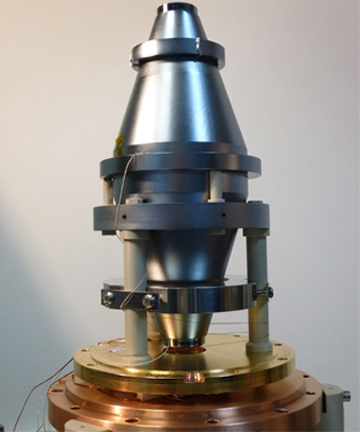
One of the two silicon resonators of the ultrastable lasers developed by German and American physicists. [Image: Physikalisch-Technische Bundesanstalt]
Scientists in Germany and the United States have built a pair of infrared lasers with linewidths below 10 mHz or 0.01 Hz (Phys. Rev. Lett., doi:10.1103/PhysRevLett.118.263202). The ultrastable lasers could lead to more precise optical clocks and even play a role in future cutting-edge astrophysical experiments.
Stamping out fluctuations
The researchers at Physikalisch-Technische Bundesanstalt (PTB) in Braunschweig, Germany, and JILA in Boulder, Colo., USA, say their lasers incorporate 21-cm-long single-crystal silicon Fabry-Pérot resonators operating at a frequency of 194.4 THz and a temperature of 124 K. By seeking out and suppressing various sources of noise, the team got the fluctuations in the length of the lasers’ cavities down to roughly 10–17 of the length.
The cavity mirror pairs were coated with layers of silicon dioxide and tantalum pentoxide. The scientists aligned the cavities vertically to reduce vibrations from seismic and acoustic sources. Then, with the lasers sitting on separate isolated tables, the researchers compared the frequency instabilities to that of a third ultrastable laser of a different type.
Clocking in
According to the authors, the lasers have a coherence time of 11 to 55 s, and an individual laser linewidth as small as 5 mHz. Future experiments could drive the thermal noise even lower by either dropping the temperature down to cryogenic levels (the 4 K range) or changing the mirror coatings to the less noisy aluminum gallium arsenide.
JILA is partly supported by the U.S. National Institute of Standards and Technology, which, like PTB, governs the nation’s “official time.” In the future, the new lasers will transmit signals over an optical network to help PTB correlate its optical clocks with those of other European countries; their U.S. counterparts plan a similar effort. Other potential uses for the ultrastable lasers include quantum-correlation experiments, very-long-baseline interferometry in the submillimeter region, and gravitational-wave detectors.
